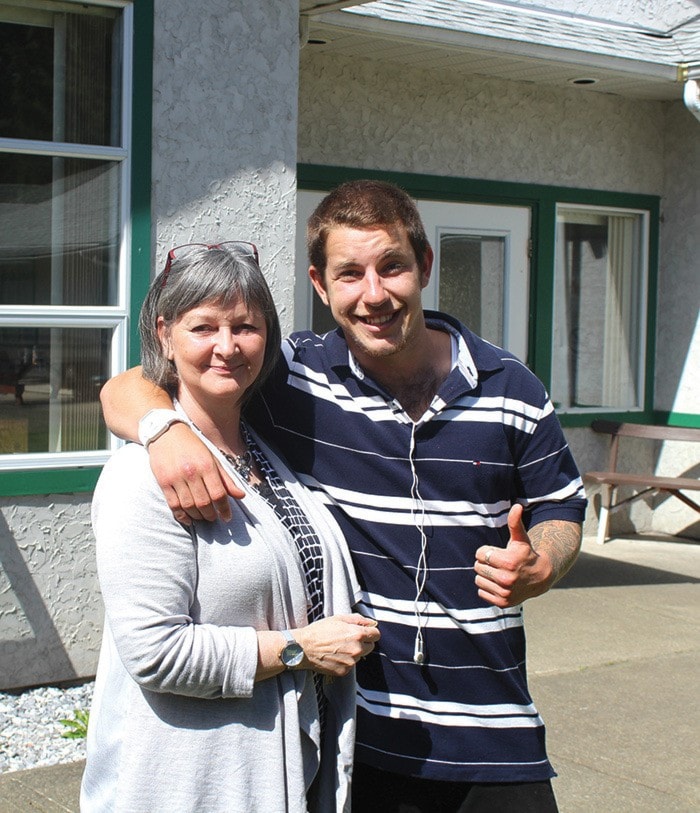Cole Corrigall had led an active lifestyle in his hometown of Victoria, working at construction sites and exercising at gyms. But he was also into partying, which began in his early-teens and started to escalate at age 17. By then he had dropped out of school and entered the workforce.
“It would be all weekend and during the week,” said Corrigall, 22. “That was when I was just drinking. About 18 or 19 it started escalating a bit more. Drugs were coming into play. Just kind of turned into a big couple years-long party.”
Cole was struggling with life, hitting “all-time lows” and “thinking really bad things.” Feeling hopeless, he wound up in a hospital psych ward, and then in detox with a social worker. But counselling wasn’t helping — he needed “the full-out program.”
Several weeks ago, Cole entered the Comox Valley Recovery Centre — and began the process of turning his life around. By staying clean and sober, and dealing with “inner issues,” he’s adopting a new outlook on life.
“Never noticed things until you write it down, talk about it, and get down and do it. Noticed a chain reaction in how I was dealing with things. Started to look at it from a different point of view. In my addiction, I was just looking at it in my own little bubble, so I never saw how bad it was, and here it kind of opened that up and I had to look at myself in a different way. It made me feel better.”
He says the meetings that involve fellow residents are his “saving grace.”
“It’s just nice to share the struggle with someone,” said Cole, who plans in September to study accounting in college.
Corrigall is one of about 20 residents at the Recovery Centre, which helps more than 300 chemically-dependent men each year. Clients come from various corners of the country. The average age is early-40s, though one gent was 97.
“There’s no prejudice in addiction,” administrator Jane Worth said. “It doesn’t matter what age you are, which sex you are, what religious affiliation you are. We have everything here.”
Each resident lives with a roommate in a cottage, which contains two bedrooms and a shared bathroom. For the most part, the arrangement works. The exceptions are the snorers, who live in unit #6.
“There’s rarely an incident at the Recovery Centre,” Worth said. “They’re able to manage themselves, they’re able to live compatibly with the rest of the residents.
“We see the best in them,” she added. “It’s about teaching the clients to have a voice for themselves. Be proud of the recovery.”
Residents are supported with daily recovery practices through a 28-, 42-, 60- or 90-day program. Upon graduation, a ceremony is held. After leaving the facility, graduates are invited back for a one-year celebration, and a place on the alumni list. Many choose to return as guest speakers.
Residents need to abide by various rules, including a 10 p.m. curfew. They aren’t allowed to frequent bars, pool halls, arcades or casinos. Each week, clients are required to attend three outside Alcoholics Anonymous/Narcotics Anonymous meetings. But there’s also time for fun. Wednesday afternoons, for instance, are spent at the bowling alley.
This year is a milestone for the centre, which celebrates 40 years of service at the end of July. It was originally called Pidcock House — the name of the Salvation Army emergency shelter which backs onto the eight acres.
“This property was vacant land,” said Worth, recalling how the entire community was involved in transforming the acreage into the Recovery Centre. “They were a little short with funds to open it. In those days, Stan Hagen was the MLA, and he secured a grant to open it.”
In an effort to provide a full continuum of services, the centre is working to establish aftercare (transitional) housing for clients. The goal is to house four men at a time, with support, for two years, though the time frame is negotiable. The modular units will contain four bedrooms, two bathrooms, and a kitchen/living/dining space in the middle.
“This has been in the back of our mind for a long time, and it was through the support and the coming together of the Comox Valley Coalition to End Homelessness,” Worth said.
The housing project will be named after Harold Stevens, a founding member of the Recovery Centre. Residents at Stevens House will need to attend school, or perhaps work part-time or volunteer.
“They need to be contributing in some way during the course of the day,” Worth said.
The Recovery Centre was a finalist in the non-profit organization category at the last Chamber of Commerce Community Awards.
In 2014, the centre founded a Presidents Club. Members donate a minimum of $300 per year, which supports client services.
The centre is located at 641 Menzies Ave. in Courtenay. It hosts an open house Saturday, July 30 from noon to 4 p.m. There will be a live auction and a barbecue by donation.
For more information, or to donate to the aftercare project, call 250-338-7144.
